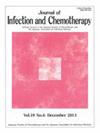Cellulitis with bacteremia caused by Pseudomonas mosselii in a Japanese patient: A case report
IF 1.5
4区 医学
Q3 INFECTIOUS DISEASES
引用次数: 0
Abstract
Pseudomonas mosselii is a glucose-nonfermenting, rod-shaped, Gram-negative bacterium commonly found in soil and water. There are only a few cases of P. mosselii infection. Here, we present a case of cellulitis with bacteremia caused by P. mosselii.
A 63-year-old Japanese woman with a history of stasis dermatitis, lower extremity ulcers, and poorly controlled diabetes presented to the emergency department with fever and left lower leg pain. She was diagnosed with cellulitis. Gram-negative rods were detected in one aerobic blood culture bottle and subsequently identified as P. mosselii using matrix-assisted laser desorption ionization-time of flight mass spectrometry (MALDI-TOF MS) and 16S ribosomal RNA (16S rRNA) gene sequencing. She was initially treated with cefepime. Based on the antibiotic susceptibility of P. mosselii, treatment was switched to ceftazidime. Antibiotics were administered for 14 days. However, due to cellulitis recurrence, antibiotic therapy was resumed for an additional 14 days. She was subsequently discharged from the hospital with no further recurrence.
Accurate identification of P. mosselii using MALDI-TOF MS and 16S rRNA gene sequencing facilitated appropriate clinical management. Furthermore, this case suggests that P. mosselii may inhabit human environments and can cause community-acquired infections.
日本莫塞假单胞菌引起蜂窝织炎伴菌血症1例
莫塞假单胞菌是一种不发酵葡萄糖的棒状革兰氏阴性细菌,常见于土壤和水中。只有少数感染莫塞疟原虫的病例。在这里,我们提出一个蜂窝织炎与菌血症引起的莫塞螺旋体。一名63岁日本女性,有瘀血性皮炎、下肢溃疡和控制不良的糖尿病病史,以发烧和左下肢疼痛就诊于急诊科。她被诊断为蜂窝织炎。在一个有氧血培养瓶中检测到革兰氏阴性棒,随后通过基质辅助激光解吸电离飞行时间质谱(MALDI-TOF MS)和16S核糖体RNA (16S rRNA)基因测序鉴定为莫塞螺旋体。她最初用头孢吡肟治疗。根据莫塞螺旋体的抗生素敏感性,改用头孢他啶治疗。抗生素治疗14天。然而,由于蜂窝织炎复发,抗生素治疗又恢复了14天。她随后出院,没有再复发。利用MALDI-TOF质谱和16S rRNA基因测序技术对莫塞螺旋体进行准确鉴定,有利于临床管理。此外,该病例提示莫塞疟原虫可能栖息在人类环境中,并可引起社区获得性感染。
本文章由计算机程序翻译,如有差异,请以英文原文为准。
求助全文
约1分钟内获得全文
求助全文
来源期刊

Journal of Infection and Chemotherapy
INFECTIOUS DISEASES-PHARMACOLOGY & PHARMACY
CiteScore
4.10
自引率
4.50%
发文量
303
审稿时长
47 days
期刊介绍:
The Journal of Infection and Chemotherapy (JIC) — official journal of the Japanese Society of Chemotherapy and The Japanese Association for Infectious Diseases — welcomes original papers, laboratory or clinical, as well as case reports, notes, committee reports, surveillance and guidelines from all parts of the world on all aspects of chemotherapy, covering the pathogenesis, diagnosis, treatment, and control of infection, including treatment with anticancer drugs. Experimental studies on animal models and pharmacokinetics, and reports on epidemiology and clinical trials are particularly welcome.
 求助内容:
求助内容: 应助结果提醒方式:
应助结果提醒方式:


